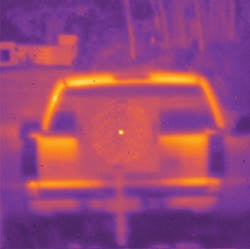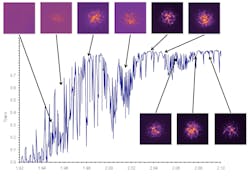Compact and robust laser sources capable of long-range atmospheric propagation are needed for applications ranging from free-space optical communication to directed energy. Fiber lasers are ideal for such applications as they offer high efficiency, low beam divergence, and robust construction. To offer the greatest possible utility, such fiber lasers should be "eye-safe" (wavelength longer than 1.4 µm) and provide powers much greater than 100 W to allow for long-range propagation.
Tunability and high power
A team at The College of Optics and Photonics (CREOL) at the University of Central Florida (UCF; Orlando, FL) has been working closely with Nufern (East Granby, CT) to develop high-power thulium (Tm) fiber lasers appropriate for atmospheric propagation and testing. This study requires a portable high-power fiber-laser system with narrow linewidth and wide wavelength tunability. Thulium3+-doped silica fibers enable tunable laser output from approximately 1800 to 2150 nm. These fibers can be pumped efficiently with high-power 790 nm laser diodes due to a cross-relaxation process in which two signal photons are generated from a single absorbed pump.1
Tunability is most easily achieved using a gold-coated reflection grating on a rotation stage as a feedback mechanism; however, the grating is not appropriate for a high-power laser cavity due to linewidth broadening and thermal distortion. To solve these problems, a master oscillator power amplifier (MOPA) system was developed.2 The master oscillator is based on 10 µm core/125 µm cladding polarization-maintaining (PM) fiber and provides up to 12 W of linearly polarized light from 1895 to 2110 nm, of which 1920 to 2097 nm can be used to seed the power amplifier (PA). The PA is bidirectionally pumped with two 300 W, 793 nm diodes and produces more than 200 W over a greater than 150 nm tuning range with hours of stable operation.
Confirming simulations
This portable laser system was recently installed at the Innovative Science & Technology Experimentation Facility (ISTEF) laser range (Merritt Island, FL) for atmospheric-propagation testing. Images of the beam were captured using an indium antimonide camera along the 1 km test range (see figure). Initial tests agree with simulations using moderate resolution atmospheric transmission (MODTRAN) code, which accounts for the affects of the various atmospheric layers on wavelength-dependent transmission. Given the same initial laser power, there is a wide variation in the power transmitted at 1 km. Experiment and simulation show there is a broad transparency window from 2025 to 2100 nm, as well as a reduction in transmission at approximately 2015 nm. High propagation loss for wavelengths shorter than 1960 nm is due mainly to water vapor absorption.REFERENCES
- S.D. Jackson, Optics Communications 230, 1-3, 197 (January 15, 2004).
- T.S. McComb et al., The Conf. on Lasers and Electro-Optics/International Quantum Electronics Conference, OSA Technical Digest, paper CThR5 (2009).



